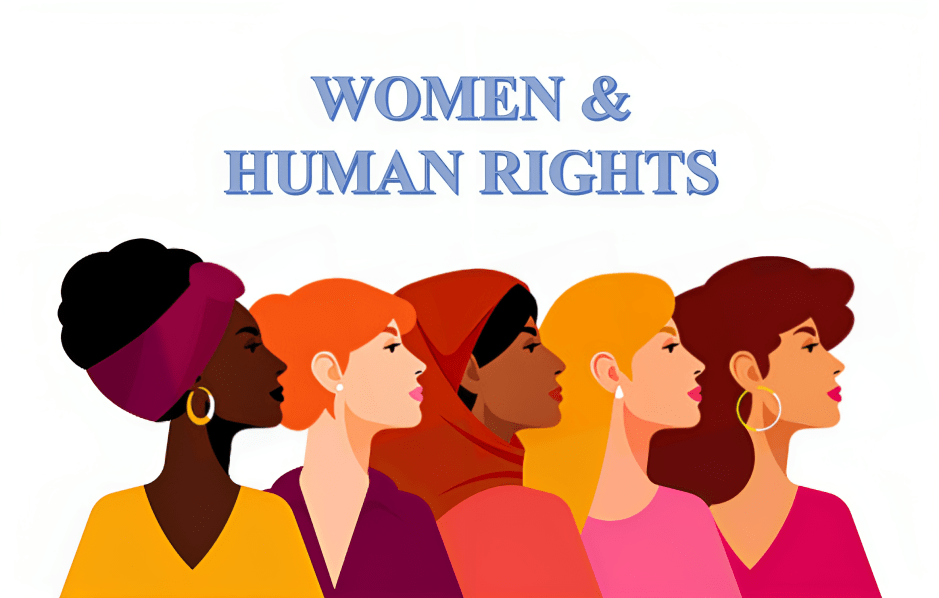
ABSTRACT
Human rights are the minimum, equal, and unalienable privileges that each and every person has as a result of being a part of the global human family, regardless of gender, ethnicity, language, race, religion, nationality, or any other distinction. In every sphere of life, women must contend with gender-based prejudice, unfairness, and dishonor. This assignment is based on secondary data that was gathered from a variety of books, newspaper articles, and reports.
Keywords: Women, Discrimination, Harassment, Crimes, Human Rights, Violation.
INTRODUCTION
Fundamental human rights and UN values include achieving gender equality and eliminating all forms of discrimination against women. In recent decades, significant progress has been made in protecting women’s rights around the world. The United Nations has a long history of addressing women’s human rights.
Because of their age, ethnicity, nationality, religion, health, marital status, education, handicap, and socioeconomic status, among other factors, some groups of women experience additional forms of discrimination. When creating policies and strategies to combat discrimination against women, it is important to take into account these intersecting kinds of prejudice.
PROTECTION OF THE HUMAN RIGHTS OF WOMEN UNDER INTERNATIONAL LAW
One of the most essential safeguards of human rights ever since the United Nations’ foundation has been gender equality. The United Nations Charter, which was adopted in 1945, lists “to reaffirm faith in fundamental human rights, in the dignity and worth of the human person, [and] in the equal rights of men and women” as one of its objectives.
In addition, Article 1 of the Charter states that one of the goals of the UN is to advance respect for fundamental freedoms and human rights “without regard to race, sex, language, or religion.” Its Articles 13 (General Assembly’s mandate) and 55 (Promotion of Universal Human Rights) reiterate the prohibition on sex-based discrimination.
Adoption of the Universal Declaration of Human Rights took place in 1948. It also stated that women and men were entitled to the same rights as those listed in it, “without distinction of any kind, such as sex.” When the Declaration was being written, there was a lot of debate over why “all men” was used instead of a language that was gender neutral. In order to make it clear that the Universal Declaration was meant for both men and women, the phrase “all human beings” and “everyone” were used to accept the Declaration.
Vienna Declaration And Programme Of Action
Vienna hosted the World Conference on Human Rights in 1993. It aimed to assess the state of the human rights apparatus at the time. Under the banner “Women’s Rights are Human Rights,”
advocates for women’s rights mobilised to make sure that women’s human rights were fully on the agenda of the international community.
Civil society activists organised tribunals, particularly around the issue of violence against women, to draw attention to rights abuses that had gone unreported because they were viewed as private matters, taboo, or just accepted as inevitable parts of women’s life. The Vienna Declaration and Programme of Action, which the Conference successfully adopted, stated that:
The human rights of women and of the girl-child are an inalienable, integral and indivisible part of universal human rights and placed particularly heavy emphasis on eliminating all forms of gender-based violence.
Importantly, the Programme of Action also called for the eradication of any conflicts which may arise between the rights of women and the harmful effects of certain traditional or customary practices, cultural prejudices and religious extremism
The Commission On The Status Of Women
By United Nations Economic and Social Council resolution 2/11 in 1946, the Commission on the Status of Women was established “to prepare recommendations and reports to the [Council] on promoting women’s rights in the political, economic, civil, social, and educational fields.”
The Commission is also required to advise the Council on “urgent problems requiring immediate attention in the field of women’s rights”. The Commission meets once a year to discuss the year’s top themes and to reach consensus on conclusions. The agreed-upon recommendations are directed to governments, international organisations, civil society, and other stakeholders and contain an assessment of the progress, gaps, and problems. A number of decisions related to women’s rights are also adopted by the Commission.
Throughout its history, the Commission has played a key role in promoting women’s rights, actively contributing to landmark international legal and policy instruments, such as the Convention on the Elimination of All Forms of Discrimination against Women, the Declaration on the Elimination of Violence against Women and the Beijing Declaration and Platform for Action.
WOMEN’S HUMAN RIGHTS UNDER CONSTITUTIONAL FRAMEWORK
All other laws in India are governed by the rules of the Indian Constitution, which is considered to be the country’s highest law. “Justice”—social, economic, and political—“Liberty”—of thinking, speech, belief, and worship—“Equality”—of status and of opportunity and dignity of the person and the integrity of the nation—“are guaranteed for all its citizens by the Indian constitution.” The preamble of the Indian constitution guarantees the fundamental human rights of all men and women with similar language. From the standpoint of women’s human rights, however, a special protection has also been given to women under the provisions of the constitution.
Right to Equality under Article 14:
According to Article 1 of the UDHR, all people are born free and with equal rights, and Article 7 establishes equality before the law. Because the state cannot refuse any person equality before the law or equal protection under the law on Indian territory, women have the same legal standing as males under the country’s constitution.
Article 2 of the UDHR guarantees that all rights and freedoms are unaffected by discrimination. Equal protection against discrimination is also discussed in Article 7. Because the state cannot discriminate against any citizen solely on the basis of religion, race, caste, sex, or place of birth, Indian citizens are also not subject to sex discrimination by any government entity.
Furthermore, no citizen will be subject to any disability, obligation, limitation, or condition with respect to: Considering stores, public restrictions, hotels, and entertainment venues
Use of wells, tanks, bathing Ghats, highways, and public resorts that are fully or partially maintained with public funding or intended for use by the general public. The state may, however, provide particular measures for women in accordance with paragraph (3) of the article as an exception to the general prohibition against discrimination.
Right to freedom of speech and expression
Due to the fact that all citizens, whether male or female, are afforded equal opportunity in matters relating to employment or appointment to any office under state and local government, women can get public work. No citizen may be excluded from or subject to discrimination in regard to employment or office under the state solely on the basis of their religion, race, caste, sex, descent, place of birth, or residency, or any combination of these factors.However, reserve regulations may be established by the government. Article 19 of the UDHR states that everyone has the right to freedom of speech and expression. Women have the right to speak out on any issue that affects them thanks to Article 19 (1) (a) of the Indian Constitution, which grants everyone the right to free speech and expression.
Right to work
UDHR in its article 23(1) confirms right to work, to free choice of employment, to just and favourable conditions of work and to protection against unemployment to everyone. Recognising such right in its structure Indian Constitution through article 19 (1) (g) provides the right to work to Indian women by ensuring freedom to all citizens for occupation, profession and business.
Right to Life and Personal Liberty
Right to life, liberty and security of person has been recognised under article 3 of UDHR. Article 21 of Indian Constitution also provides right to live to all women and men as per their own choice by constitutional guarantee that no person shall be deprived of his/her life or personal liberty except according to procedure established by law.
Right against exploitation
Article 5 of the UDHR protects against torture and other cruel, inhuman, or degrading treatment. Article 23 of the Indian Constitution provides protection from human trafficking and bonded
labour, acting as a barrier for women’s safety and guaranteeing their right to employment. The Suppression of Immoral Trafficking in Women and Girls Act, 1956, afterwards known as the Immoral Trafficking (prevention) Act, was passed by the Indian parliament to carry out the concept of this article. The state is required by the Constitutional Scheme of Directive Principles of State Policy to protect the notion of women’s rights in society.
Right to a Sufficient Means of Subsistence
According to Article 39(a), every citizen, whether a man or a woman, is entitled to a sufficient means of subsistence. Article 23(3) of the UDHR, which states that everyone who works has the right to just and suitable remuneration, recognises the same right.
Equal Pay for Equal labour
Article 39 (d) of the Indian Constitution mandates that the state must specifically direct its policies towards ensuring that men and women receive equal pay for doing the same amount of labour. Such a right is likewise provided by the UDHR’s article 23(2).
Maternity Relief and Just and Human Conditions of labour
Article 42 of the Constitution mandates that the state make provisions for maternity relief and just and human conditions of labour.
Right to Constitutional Remedies
If one of these fundamental rights has been violated, the aggrieved woman may file a writ petition under Articles 32 and 226 and go before the Supreme Court or the High Court to seek redress. However, there is no such mechanism available in the case of Directive Principles of State Policy, which are not enforceable by any court with writ jurisdiction. Such ideals must be put into practise by the state through its policy. As a result, the state is morally obligated to implement Directive Principles of State Policy.
CONCLUSION
True equality won’t exist until women and girls have complete access to all of their rights, including those related to sexuality, freedom from violence, access to education, and maternal health. Economies and nations won’t change until women have assumed leadership and peacemaking responsibilities and have an equal political voice. And only then will all women and girls possess the right to self-determination.
REFERENCES
Hosken, Fran P., ‘Towards a Definition of Women’s Rights’ in Human Rights Quarterly, Vol. 3, No. 2. (May 1981), pp. 1–10.
Lockwood, Bert B. (ed.), Women’s Rights: A “Human Rights Quarterly” Reader (Johns Hopkins University Press, 2006), ISBN 978-0-8018-8374-3.
Kramer, Samuel Noah (1963), The Sumerians: Their History, Culture, and Character, Chicago, Illinois: University of Chicago Press, p. 78, ISBN 978-0-226-45238-8
Johannes Morsink, “Women’s rights in the Universal Declaration”, Human Rights Quarterly, vol. 13, No. 2 (May 1991)
United Nations Centre for Human Settlements, Women’s Rights to Land, Housing and Property in Post-conflict Situations and During Reconstruction: A Global Overview, Land Management Series No. 9 (Nairobi, 1999), p. 12.
India Const. art. 14
India Const. art. 15 (1).
India Const. art. 15 (2)
India Const. art. 16
India Const. art. 16 cl. 3 & 4
Written by Areeba Ahad
B.A.LL.B graduate
Vitasta School of Law and humanities affiliated with University of Kashmir




0 Comments